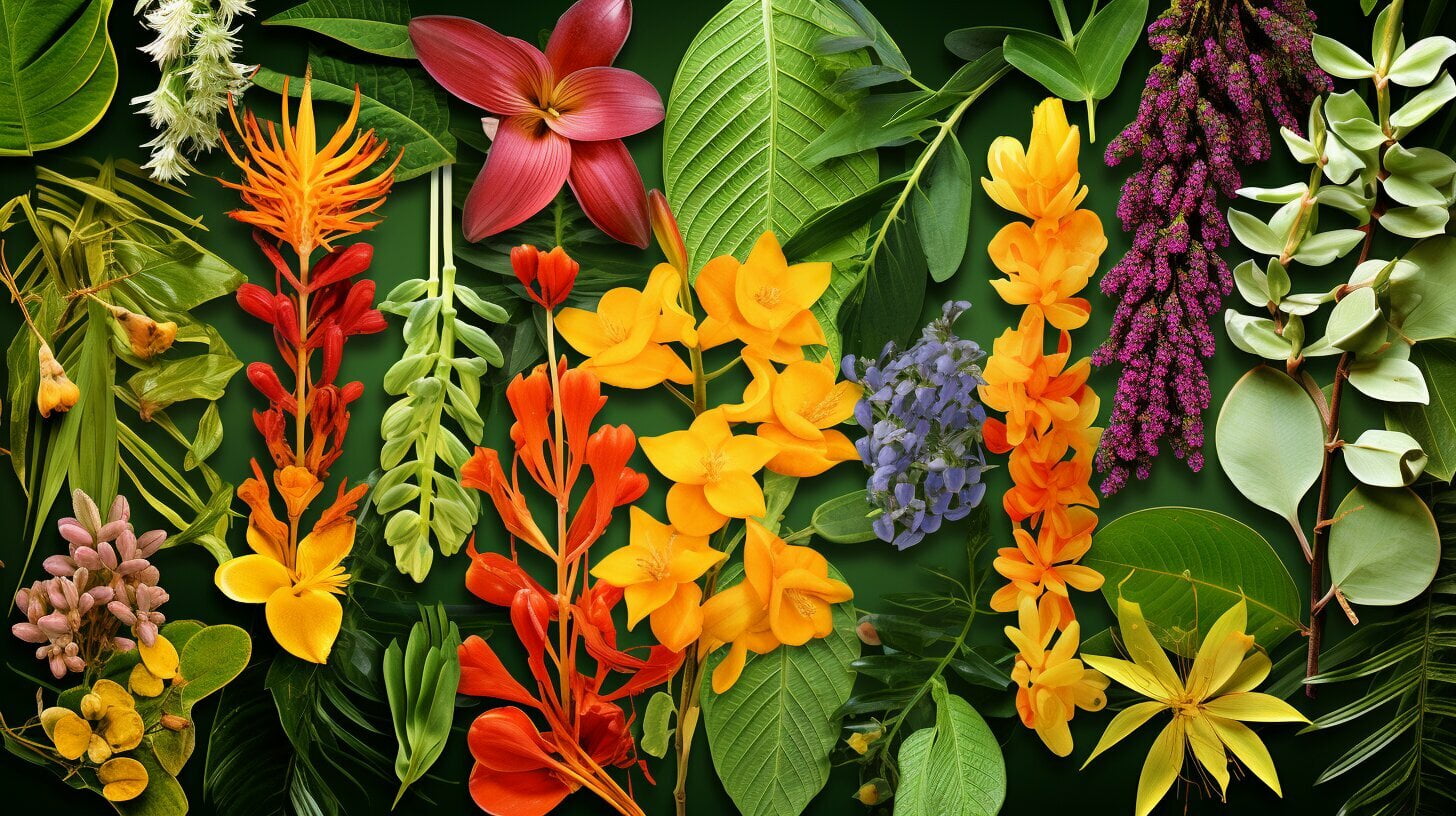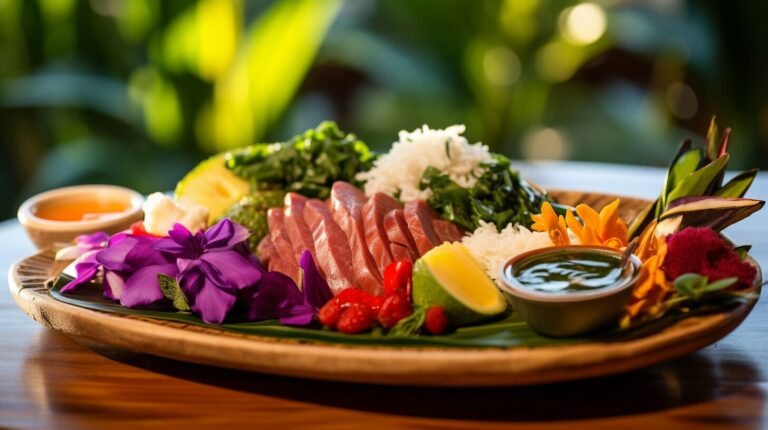Explore the Healing Power of Hawaiian Herbal Medicine 🌿
Hawaiian Herbal Medicine has a rich history of traditional healing practices and a wide array of medicinal plants that have been used for centuries to promote overall wellness and enhance holistic health in the Hawaiian islands. The indigenous knowledge and practices of Hawaiian healers have been passed down through generations, making Hawaiian herbal medicine a valuable resource for natural remedies and plant-based healing.
Key Takeaways:
- Hawaiian Herbal Medicine is deeply rooted in the history and culture of Hawaii, with traditional healing practices and medicinal plants playing a significant role in promoting wellness.
- The most prominent herbal remedies in Hawaiian medicine include Kava, Mamaki, Noni, ‘Olena, Kukui, and Uhaloa, known for their various properties and benefits for different health conditions.
- Hawaiian herbal medicine follows a holistic approach to wellness, recognizing the interconnectedness of mind, body, and spirit in promoting overall well-being.
- Modern research is ongoing to validate the efficacy of Hawaiian herbal remedies and their applications in modern healthcare practices.
- Cultural preservation and sustainability are important in the preservation and promotion of Hawaiian herbal medicine, including efforts to protect and cultivate medicinal plants.
The History and Cultural Significance of Hawaiian Herbal Medicine
Hawaiian Herbal Medicine has deep roots in the cultural traditions of the indigenous Hawaiian people, who have long relied on the healing properties of medicinal plants to address various health concerns and maintain overall well-being. These traditional healing practices have been passed down through generations, preserving the wisdom and knowledge of the ancient Hawaiians.
Historically, local Hawaiian healers have utilized medicinal herbs for their healing properties. The utilization of herbs varied among different tribes, each recognizing the diverse benefits beyond their medicinal properties. Today, these herbs are not only used for their therapeutic value but also for promoting dietary health and a better lifestyle.
One of the valued herbs used by Hawaiian healers is Kava, also known as Kava-Kava or awa. Traditionally consumed as a drink, Kava induces a slight loss of muscle control while keeping the mind clear. It also possesses pain-relieving properties, making it effective for alleviating headaches and back pains. Another herb, Mamaki, is used for making tea and has strong medicinal properties. It is known to soothe coughs, sore throats, and thrush. Mamaki leaves can be mixed with different ingredients like lemon grass, honey, or lemon to enhance its character and flavor.
The Noni plant is highly regarded among Hawaiian healers, especially its fruit. While the fruit itself has a distinctive smell and flavor, it is renowned for its potential to treat severe illnesses such as hypertension, heart diseases, and diabetes. Noni leaves are also used for skin treatments, particularly in skin infections and cancers. Additionally, ‘olena, or turmeric, is another important plant used in Hawaiian medicine. It is applied externally to treat skin sores and rashes and can help alleviate sinus infections and congestion.
| Herb | Traditional Uses |
|---|---|
| Kava | – Induces slight loss of muscle control – Eases headaches and back pains |
| Mamaki | – Soothes coughs, sore throats, and thrush – Can be mixed with lemon grass, honey, or lemon for added flavor |
| Noni | – Treats severe illnesses such as hypertension, heart diseases, and diabetes – Used for skin treatments in skin infections and cancers |
| Olena (Turmeric) | – Applied externally to treat skin sores and rashes – Helps alleviate sinus infections and congestion |
The cultural significance of Hawaiian herbal medicine lies in its connection to the indigenous traditions and the preservation of ancestral knowledge. These herbal healing traditions are deeply rooted in the belief of achieving harmony between the mind, body, and spirit, as well as the harmonious relationship with the environment and the community. In Hawaiian culture, the interconnectedness of all aspects of life is recognized, and herbal remedies play a vital role in promoting overall well-being and holistic health.
As Hawaii continues to embrace modern healthcare practices, the integration of traditional Hawaiian herbal medicine is gaining recognition. Ongoing research aims to validate the efficacy of these traditional remedies, further contributing to the evidence-based practice of Hawaiian herbal medicine. Efforts are also being made to preserve and sustain the cultural traditions surrounding these healing practices, including the protection and cultivation of medicinal plants to ensure their availability for future generations.
Key Herbal Remedies in Hawaiian Medicine
Hawaiian Herbal Medicine encompasses a vast array of herbal remedies, each with its unique healing properties and medicinal benefits, which play a crucial role in traditional healing practices. These remedies have been passed down through generations, preserving the indigenous knowledge and wisdom of the Hawaiian people. From the lush jungles to the shores of Hawaii, medicinal plants have been utilized for their therapeutic qualities and their ability to promote holistic wellness.
Among the key herbal remedies in Hawaiian Medicine, Kava is one of the most widely recognized and utilized plants. Also known as Kava-Kava or awa, it is consumed as a ceremonial drink or used medicinally to alleviate headaches and back pains. Kava has pain-relieving properties and can induce a state of relaxation and euphoria, without impairing cognitive function. It is traditionally prepared by pounding the roots and soaking the crushed parts in water to extract the active compounds, known as lactones. Today, powdered Kava is available in capsules or as a tea for convenient consumption.
Mamaki is another valued herb used by Hawaiian healers. Its leaves are harvested and dried to make a soothing tea. Mamaki has therapeutic properties and is often blended with ingredients like lemongrass, honey, or lemon for added flavor and medicinal benefits. It is known for its ability to alleviate coughs, sore throats, and thrush. The different varieties of Mamaki leaves hold diverse healing effects and are selectively utilized by traditional practitioners.
Noni, also known as Indian Mulberry, is highly esteemed in Hawaiian traditional medicine. Both the leaves and fruits of the Noni tree are utilized for their powerful medicinal properties. Noni juice, when mixed with ginger or orange juice, is believed to have significant health benefits, including the alleviation of hypertension, heart diseases, and diabetes. Noni leaves are used topically for skin treatments, specifically for skin infections and cancers. This versatile plant has a strong, unique aroma and is considered a staple in Hawaiian herbal medicine.
Table: Key Herbal Remedies in Hawaiian Medicine
| Herb | Common Name | Uses |
|---|---|---|
| Kava | Piper methysticum | – Alleviates headaches and back pains – Promotes relaxation and euphoria – Traditional ceremonial drink |
| Mamaki | Pipturus albidus | – Soothes coughs and sore throats – Assists in treating thrush – The leaves can be blended with other ingredients for added benefits |
| Noni | Morinda citrifolia | – Helps lower blood pressure and manage heart diseases – Assists in managing diabetes – Used topically for skin infections and cancers |
These are just a few examples of the key herbal remedies in Hawaiian Medicine. Each plant has its unique properties and uses, contributing to the holistic well-being and traditional healing practices of the Hawaiian people. These herbal remedies are a testament to the rich cultural heritage and deep connection to the natural environment that characterizes Hawaiian herbal medicine.
Traditional Preparation Methods
In Hawaiian Herbal Medicine, the preparation and administration of herbal remedies involve traditional practices that have been passed down through generations, ensuring the preservation of indigenous knowledge and the effectiveness of these medicinal plants. The healers in Hawaii have deep-rooted respect for the plants and believe in the importance of harvesting them sustainably.
One of the valued herbs utilized by Hawaiian healers is ‘Kava’ (Piper methysticum), which is traditionally consumed as a drink. The preparation involves pounding the Kava roots in a pot and soaking the crushed parts in water to extract the active ingredients, such as lactones. The extracted liquid is then consumed warm or cold after straining. The different strains of Kava found in Hawaii, such as Purple moi, Hiwa, Mahakea, and Nene varieties, are mostly found in shady places in the jungles.
‘Mamaki’ (Pipturus albidus), another prominent herb in Hawaiian medicine, is primarily used for making tea. The leaves of Mamaki are harvested and dried before being prepared. The herb has different uses based on the type of leaves used, including soothing cough and sore throat when consumed as tea. It is often mixed with lemon grass, honey, or lemon to enhance its flavor and medicinal properties. Mamaki is an endemic species in Hawaii, belonging to the nettle family, and is commonly found in wet and occasionally wet forests.
‘Noni’ (Morinda citrifolia), considered one of the most highly regarded traditional Hawaiian medicinal herbs, has both its leaves and fruits utilized for their healing properties. The leaves are softened and applied to affected areas of the skin, while the ripe fruit, often referred to as Noni berry, is known for its distinct aroma. Noni is used in various forms, such as juice, tea, capsules, and body oil. It is believed to have therapeutic effects on conditions like hypertension, heart diseases, and diabetes. Noni is a traditional Hawaiian medicinal plant that grows from 10 to 20 feet tall, with shiny dark green leaves used for skin treatments and infections.
| Herb | Preparation | Uses |
|---|---|---|
| Kava (Piper methysticum) | Pound the roots and soak in water | Consumed as a drink for relaxation and pain relief |
| Mamaki (Pipturus albidus) | Dry the leaves and make tea | Soothes cough, sore throat, and thrush |
| Noni (Morinda citrifolia) | Extract juice from leaves and cool for skin applications | Treats skin infections, gastrointestinal diseases, and more |
These are just a few examples of the traditional preparation methods used in Hawaiian herbal medicine. The use of these herbs and the preparation techniques highlight the deep cultural significance and effectiveness of Hawaiian healing traditions. It is important to preserve and promote these practices to ensure the continued well-being and holistic health of the Hawaiian community.
Holistic Wellness and Healing Philosophy
Hawaiian Herbal Medicine takes a holistic approach to wellness, recognizing the interconnectedness of the mind, body, and spirit, and emphasizing the importance of achieving balance and harmony for optimal health. In Hawaiian culture, the concept of “ola” or well-being encompasses not only physical health but also mental and spiritual well-being. Traditional healing practices and herbal remedies play a vital role in promoting holistic wellness in Hawaii, supporting the body’s natural ability to heal and restore balance.
Hawaiian herbal medicine is deeply rooted in the belief that nature provides abundant resources for healing and nourishment. Plant-based healing is central to Hawaiian traditional remedies, with medicinal plants playing a significant role in promoting wellness. Herbal remedies are carefully selected and prepared to harness the healing properties of specific plants, addressing various health conditions and promoting overall well-being. The use of herbal medicine practices in Hawaii is a reflection of the rich indigenous knowledge passed down through generations.
The Healing Power of Hawaiian Medicinal Herbs
There are several key herbal remedies commonly used in Hawaiian medicine that have been proven to have notable health benefits. One such herb is Kava (Piper methysticum), which is traditionally consumed as a beverage. Kava has pain-relieving properties and can reduce headaches and back pains. It is known to induce a sense of euphoria while keeping the mind clear. Another valued herb is Mamaki (Pipturus albidus), which is used to make tea and has soothing properties for coughs and sore throats. Noni (Morinda citrifolia) is highly regarded for its ability to treat serious ailments such as heart diseases and diabetes, while Turmeric (‘Olena) is prized for its anti-inflammatory properties and is used to treat skin infections and sinus problems.
The traditional preparation methods of these herbs involve extracting and preserving their active ingredients to maximize their healing potential. The effectiveness of Hawaiian herbal remedies lies in the careful selection and combination of plants, ensuring a holistic approach to healing. By addressing the root causes of health issues and promoting overall well-being, Hawaiian herbal medicine offers a unique and comprehensive system of healing that goes beyond treating symptoms.
It is important to note that Hawaiian herbal medicine is not just about physical healing but also encompasses the spiritual and emotional aspects of wellness. The practices and traditions passed down through generations emphasize the importance of connecting with nature, cultivating a sense of gratitude, and embracing a harmonious relationship with the environment. This deep connection to nature and the concept of “mana” or life force energy is integral to the holistic wellness philosophy of Hawaiian herbal medicine.
Hawaiian Herbal Medicine Today
In modern healthcare practices, Hawaiian herbal medicine continues to play a significant role in promoting holistic wellness. Research is being conducted to validate the efficacy of traditional remedies and explore their potential applications in various health conditions. The integration of traditional healing practices with modern medicine is gaining recognition, highlighting the value of incorporating plant-based healing into conventional healthcare approaches.
Efforts are also being made to preserve and promote the cultural traditions and sustainability of Hawaiian herbal medicine. Conservation initiatives aim to protect and cultivate medicinal plants, ensuring their availability for future generations. By embracing the principles of cultural preservation and sustainability, Hawaiian herbal medicine can continue to thrive and contribute to the holistic well-being of individuals and communities in Hawaii.
| Key Herbal Remedies | Properties and Uses |
|---|---|
| Kava (Piper methysticum) | Pain-relieving, reduces headaches and back pains |
| Mamaki (Pipturus albidus) | Soothes coughs and sore throats |
| Noni (Morinda citrifolia) | Treats heart diseases, diabetes, and gastrointestinal issues |
| Turmeric (‘Olena) | Anti-inflammatory, treats skin infections and sinus problems |
Modern Applications and Research
Hawaiian Herbal Medicine continues to be integrated into modern healthcare practices, with ongoing research shedding light on the effectiveness of these natural remedies and their potential benefits for various health conditions. Traditional Hawaiian healers have long utilized medicinal herbs, such as Kava, Mamaki, Noni, and Turmeric, for their therapeutic properties. Today, these herbs are gaining recognition for their potential in promoting overall wellness and supporting a healthier lifestyle.
Research studies have explored the efficacy of these herbal remedies in treating specific health conditions. For example, studies have shown that Kava, consumed as a drink, can help reduce headaches and back pain due to its pain-relieving properties. Mamaki tea has been found to soothe coughs and sore throats, while Noni juice has shown potential in managing diabetes, high blood pressure, and heart diseases. Turmeric, with its anti-inflammatory properties, has been used to promote healing for skin conditions and sinus infections.
Furthermore, ongoing research efforts are being conducted to validate the traditional use of these herbs through scientific studies. Researchers are investigating the active compounds present in these herbal remedies and their mechanisms of action. This research aims to provide a scientific basis for the traditional healing practices and enhance the understanding of the therapeutic potential of Hawaiian Herbal Medicine.
In addition to research on specific herbal remedies, studies have also examined the integration of traditional Hawaiian healing practices, including herbal medicine, into primary care settings. These studies have explored the acceptability and cultural connectedness resulting from the integration of native healing practices, the impact on patient empowerment and well-being, and the potential for addressing health inequities among Kānaka ‘Ōiwi (Native Hawaiians).
Research Findings:
- A community-based participatory research study conducted at Waimānalo Health Center examined the integration of native healing practices into primary care. The study found that the integration provided an alternative to Western medicine and promoted cultural connectedness. Patients reported behavioral changes and improved well-being after incorporating native healing practices into their healthcare.
- Another study recommended the integration of traditional healing and Western medicine in clinics serving Kānaka ‘Ōiwi. The integrated approach aimed to increase communication between practitioners and traditional healers, ensuring culturally relevant healthcare for Native Hawaiians.
- Research conducted in various cultures, including Indigenous communities in Canada, Africa, and Asia, has shown the effectiveness and preference for integrated healing practices. Integrating Western and Indigenous healing has demonstrated positive impacts on health outcomes and cultural identity.
| Herb | Traditional Use | Prominent Benefit |
|---|---|---|
| Kava | Consumed as a drink | Pain relief, relaxation, and anxiety reduction |
| Mamaki | Used for making tea | Soothing coughs, sore throats and thrush |
| Noni | Used as a fruit or juice | Management of diabetes, high blood pressure, and heart diseases |
| Turmeric | Used externally and internally | Anti-inflammatory properties for skin conditions and sinus infections |
“The integration of traditional Hawaiian healing practices provides an alternative to Western medicine, promoting cultural connectedness and improving well-being.”
As Hawaiian Herbal Medicine gains recognition, efforts are being made to preserve the cultural traditions and sustainability of these healing practices. Initiatives are underway to protect and cultivate the medicinal plants used in Hawaiian medicine, ensuring their availability for future generations. These efforts aim to preserve the rich heritage of Hawaiian Herbal Medicine, promoting holistic wellness and plant-based healing for years to come.
Cultural Preservation and Sustainability
Cultural preservation and sustainability are essential aspects of Hawaiian Herbal Medicine, as the indigenous traditions and practices associated with these medicinal plants play a vital role in preserving the cultural heritage and promoting the well-being of the Hawaiian community. For centuries, Hawaiian healers have relied on the knowledge passed down through generations to harness the healing properties of medicinal plants for various health conditions. These traditional healing practices, deeply rooted in the cultural fabric of Hawaii, have been instrumental in maintaining the well-being of the community.
One of the key aspects of cultural preservation in Hawaiian Herbal Medicine is the sustainable cultivation and harvesting of medicinal plants. Hawaiian healers have long understood the importance of maintaining a harmonious relationship with nature and respecting the natural resources they rely on. They follow careful practices to ensure the sustainable use of medicinal plants, including selective harvesting, nurturing plant populations, and promoting regenerative growth. By preserving the biodiversity of these medicinal plants, Hawaiian healers are not only safeguarding the cultural heritage but also ensuring the availability of these valuable resources for future generations.
To further strengthen the cultural preservation and sustainability of Hawaiian Herbal Medicine, there have been efforts to educate and empower the local community about the importance of traditional healing practices. Various organizations and initiatives focus on promoting awareness and understanding of Hawaiian medicinal plants, including their uses, preparation methods, and cultural significance. These efforts help to foster a sense of pride and connection to the indigenous healing traditions, encouraging the younger generation to carry forward these invaluable practices.
Efforts in Cultural Preservation and Sustainability
- The Office of Hawaiian Affairs, in collaboration with community partners, has developed programs and resources to support the cultivation and preservation of medicinal plants. These initiatives include workshops, educational materials, and community-based gardens that promote the sustainable growth and use of Hawaiian medicinal plants.
- The University of Hawaii’s College of Tropical Agriculture and Human Resources conducts research and provides training on sustainable farming practices, including the cultivation and propagation of medicinal plants. Their efforts are crucial in ensuring the availability of these plants for medicinal purposes while minimizing the impact on natural ecosystems.
- Hawaiian cultural centers and traditional healing schools offer classes and workshops on traditional healing practices, providing opportunities for individuals to learn from experienced practitioners and gain hands-on knowledge of herbal medicine. These institutions play a vital role in preserving and transmitting the cultural wisdom associated with Hawaiian herbal healing.
By prioritizing cultural preservation and sustainability, Hawaiian Herbal Medicine continues to thrive as a source of holistic wellness and a testament to the rich cultural heritage of Hawaii. The integration of traditional healing practices with modern healthcare approaches ensures that the benefits of Hawaiian herbal medicine are accessible to all, while efforts to protect and cultivate medicinal plants contribute to the long-term sustainability of these invaluable resources.
| Efforts in Cultural Preservation and Sustainability | Organizations and Initiatives |
|---|---|
| The Office of Hawaiian Affairs | Workshops, educational materials, community-based gardens |
| University of Hawaii’s College of Tropical Agriculture and Human Resources | Research, training on sustainable farming practices |
| Hawaiian cultural centers and traditional healing schools | Classes, workshops on traditional healing practices |
Through these collective efforts, the cultural preservation and sustainability of Hawaiian Herbal Medicine are upheld, ensuring that the indigenous healing traditions and medicinal plants continue to benefit the Hawaiian community for generations to come.
Conclusion
Hawaiian Herbal Medicine offers a wealth of natural remedies and traditional healing practices that contribute to holistic wellness. The utilization of medicinal herbs has been a fundamental part of Hawaiian culture for centuries, passed down through generations. These herbal healing traditions not only promote physical health but also address the interconnectedness of mind, body, and spirit, emphasizing the importance of holistic well-being.
Through the historical and cultural significance of Hawaiian herbal medicine, we can understand the profound knowledge and wisdom embedded in these practices. Indigenous healers have recognized the therapeutic properties of medicinal plants such as Kava, Mamaki, Noni, and Turmeric, which have been used to alleviate various ailments and promote overall wellness.
The traditional preparation methods and administration techniques in Hawaiian medicine are rooted in cultural practices. These methods preserve the potent properties of the herbs and contribute to the effectiveness of the remedies. The integration of plant-based healing in modern healthcare practices and ongoing research further validates the efficacy of these traditional remedies.
Preserving and promoting the cultural traditions and sustainability of Hawaiian herbal medicine is vital for future generations. Efforts are underway to protect and cultivate medicinal plants, ensuring their availability for the continued practice of traditional healing. By embracing and honoring these herbal healing traditions, we not only preserve an essential part of Hawaiian culture but also contribute to the promotion of holistic wellness for individuals and communities.
FAQ
Q: What is Hawaiian herbal medicine?
A: Hawaiian herbal medicine refers to the traditional healing practices and remedies derived from medicinal plants and herbs native to the Hawaiian islands. It is a holistic approach to wellness that emphasizes the interconnectedness of mind, body, and spirit.
Q: What are some key herbal remedies in Hawaiian medicine?
A: Some key herbal remedies in Hawaiian medicine include kava (Piper methysticum), mamaki (Pipturus albidus), noni (Morinda citrifolia), and turmeric (Curcuma longa). These herbs have been used for centuries by Hawaiian healers for their medicinal properties and therapeutic benefits.
Q: How are herbal remedies prepared in Hawaiian medicine?
A: Herbal remedies in Hawaiian medicine are typically prepared through traditional methods such as pounding the roots or leaves, soaking them in water, or extracting the active ingredients. Different plants may require specific preparation techniques to maximize their therapeutic effects.
Q: Are there any modern applications and research on Hawaiian herbal medicine?
A: Yes, there are ongoing studies and research on the efficacy and potential applications of Hawaiian herbal medicine in modern healthcare. This research aims to validate the traditional uses of these remedies and explore their potential in treating various health conditions.
Q: Why is it important to preserve Hawaiian herbal medicine and its cultural traditions?
A: Preserving Hawaiian herbal medicine and its cultural traditions is important for the continuation of indigenous knowledge and the promotion of holistic wellness. It also helps to protect the biodiversity of medicinal plants and ensure their sustainability for future generations.







